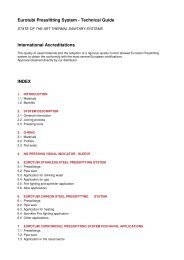Vis PDF - Damstahl
Vis PDF - Damstahl
Vis PDF - Damstahl
Create successful ePaper yourself
Turn your PDF publications into a flip-book with our unique Google optimized e-Paper software.
Chapter 1: What is Stainless Steel?<br />
Due to the low nickel content, the ferritic stainless steel types are relatively cheap compared to<br />
their austenitic parallel alloys. For that reason, the global consumption of ferritic stainless steel<br />
types is steeply increasing, in particular for purposes where one needs a bright, magnetic surface,<br />
such as fridge doors or door handles, but does not need the huge elongation of the austenites.<br />
In addition, the ferritic stainless steel types possess great advantages when dealing with ”hot<br />
equipment”. Under such conditions, the risk of SCC may be substantial. Furthermore, it may be advantageous<br />
that the thermal conductivity of the ferritic types is better than for the austenites, and<br />
the thermal elongation corresponds to that of mild steel – approximately 2/3 of that of the austenites.<br />
Duplex Stainless Steel<br />
Two-phase mixed structure containing approximately 55 % ferrite and 45 % austenite. Cr is generally<br />
high (22-26 %), Ni 1-7 %, frequently Mo and low C. With regard to pitting corrosion, crevice<br />
corrosion, general corrosion and, in particular, SCC, the corrosion resistance is normally high.<br />
Mechanically, the duplex steel types are magnetic and possess a significantly higher yield stress<br />
than both the austenitics and the ferrites. From a mechanical point of view, the duplex steel types<br />
are particularly useful for large constructions. If so, one can reduce the thickness of the steel and<br />
thereby the cost of the material and the result is more corrosion resistant steel at a lower price.<br />
The drawback of the duplex steel types is the increased costs of the manufacturing along with increased<br />
difficulties during welding. The risk of formation of intermetallic phases during heat treatment<br />
(such as welding) is substantial, and the risk increases with increasing content of Cr and Mo.<br />
For duplex steel, the thermal extension coefficient and heat transfer coefficient are somewhat in<br />
between the values of the ferritic and austenitic steel types. This means better heat transfer and<br />
less thermal elongation as compared to the austenitic stainless steel types.<br />
Precipitation hardening Stainless Steel (PH)<br />
Two-phase martensitic-austenitic stainless<br />
steel alloy typically contains 15-17 % Cr,<br />
4-8 % Ni, low Mo and up to 5 % copper<br />
(Cu). At elevated temperatures, precipitation<br />
hardening takes place due to the<br />
segregation of mainly copper containing<br />
phases.<br />
A rare example of the use of the precipitation hardening 17-4-PH<br />
alloy (EN 1.4542). Both the face and the body of this high-quality<br />
golf club have been made of the alloy.<br />
The most common (= least uncommon!)<br />
PH alloys are the 15-5 PH and the 17-4<br />
PH. Being strong and hard, they are sometimes<br />
used for chains and golf clubs,<br />
however, they are still not that common in<br />
Scandinavia.<br />
www.damstahl.com<br />
01.2013<br />
284
















